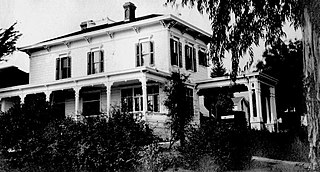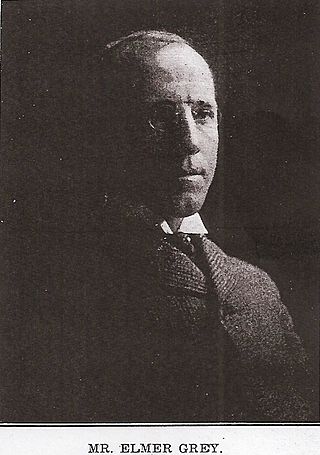
California bungalow is an alternative name for the American Craftsman style of residential architecture, when it was applied to small-to-medium sized homes rather than the large "ultimate bungalow" houses of designers like Greene and Greene. California bungalows became popular in suburban neighborhoods across the United States, and to varying extents elsewhere, from around 1910 to 1939.

Hyde Park is a neighborhood and historic district in Austin, Texas. Located in Central Austin, Hyde Park is defined by 38th Street to the south, 45th Street to the north, Duval Street to the east, and Guadalupe Street to the west. It is situated just north of the University of Texas and borders the neighborhoods of Hancock and North Loop.

The Airplane Bungalow is a residential style of the United States dating from the early 20th century, with roots in the Arts and Crafts Movement, and elements also common to the American Craftsman style, and Prairie Style. It was more popular in the western half of the U.S., and southwestern and western Canada.

Gen. Charles S. Farnsworth County Park, also known as Farnsworth Park, is a Los Angeles County park and National Register of Historic Places district in Altadena, California.

Scripps Hall, also known now as the Pasadena Waldorf School, is a large American Craftsman or Arts and Crafts style house located in the foothills of the San Gabriel Mountains, in Altadena, California, United States. It was built in 1904 as the central feature of the Scripps Estate, and is listed on the National Register of Historic Places.

The Woodbury–Story House is a National Register of Historic Places structure in Altadena, California. It was placed on the Register in 1993 for its significance as an example of Italianate and Colonial Revival architecture styles and its association with Capt. Frederick Woodbury, one of the founders of Altadena. It is currently used as a filming location.

The Drake Park Neighborhood Historic District is located adjacent to Drake Park near the historic downtown area in Bend, Oregon, United States. Because of the unique and varied architecture in the Drake Park neighborhood and its close association with the early development of the city of Bend, the area was listed on the National Register of Historic Places in 2005.

St. Andrews Bungalow Court is a grouping of bungalows built in 1919–20 in the Colonial Revival style in Hollywood, California. Based on the structures' well-preserved multi-family courtyard architecture, the grouping was added to the National Register of Historic Places in 1998. The listing included 15 contributing buildings.

The Edward Schulmerich House is a two-story private residence on East Main Street in downtown Hillsboro, Oregon, United States. Completed in 1915, the American Craftsman Bungalow style structure was constructed for state senator Edward Schulmerich and added to the National Register of Historic Places in 1991. The building retains much of the original materials used in finishing the interior, including the linoleum in the kitchen and built-in cabinets of this Airplane Bungalow.

Normandie Heights is a neighborhood in Pasadena, California. It is bordered by Woodbury Road to the north, Washington Boulevard to the south, Los Robles Avenue to the west, and Lake Avenue to the east. While the exterior of many older homes in Southern California have been coated with stucco, Normandie is distinguished by a high concentration of Craftsman homes with well-maintained wooden exteriors. Accordingly, the City of Pasadena has designated more than 50 homes in the neighborhood as architectural landmarks, many on Rio Grande Street, between Los Robles Avenue and El Molino Avenue, which was the site of the first residences in the neighborhood.

This is a list of the National Register of Historic Places listings in Pasadena, California.

Elmer Grey, FAIA was an American architect and artist based in Pasadena, California. Grey designed many noted landmarks in Southern California, including the Beverly Hills Hotel, the Huntington Art Gallery, the Pasadena Playhouse and Wattles Mansion. He is credited with being one of the pioneers in the development of the new American architecture in the early 20th century, with a focus on harmony with nature and eliminating features not belonging to the local climate and conditions. Grey was also a noted artist whose paintings are in the permanent collection of the Chicago Art Institute.

Old Towne, Orange Historic District, also known as Downtown Orange, and colloquially The Circle is a one square-mile district around Plaza Park in Orange, California, and contains many of the original structures built in the period after the city's incorporation. It is a vibrant commercial district, containing Orange County's oldest operating bank. The Historic District was listed on the National Register of Historic Places in 1997, and is the largest National Register District in California. The Old Towne Preservation Association is a non-profit organization dedicated to maintaining the district.

The Medbury's–Grove Lawn Subdivisions Historic District is a residential historic district located in Highland Park, Michigan. It runs along three east–west streets: Eason Street, Moss Street, and Puritan Street, from Hamilton Avenue on the west to Woodward Avenue on the east. The district was listed on the National Register of Historic Places in 1988.

The Oak Circle Historic District is a historic district in Wilmette, Illinois, United States. The district covers 2.6 acres (0.011 km2) and includes twenty-two contributing properties and four non-contributing properties, all located along Oak Circle. It primarily consists of fifteen single-family homes representative of the Prairie School and Craftsman styles of architecture. The Oak Circle Historic District was added to the National Register of Historic Places on June 21, 2001; it was the first historic district to be designated in Wilmette.
In the United States, the National Register of Historic Places classifies its listings by various types of architecture. Listed properties often are given one or more of 40 standard architectural style classifications that appear in the National Register Information System (NRIS) database. Other properties are given a custom architectural description with "vernacular" or other qualifiers, and others have no style classification. Many National Register-listed properties do not fit into the several categories listed here, or they fit into more specialized subcategories.

First Baptist Church of Ventura is a historic church at 101 S. Laurel Street in Ventura, California. It was built in 1926 and renovated extensively into the Mayan Revival style in 1932. Declared a landmark by the City of Ventura In 1975, the building was added to the National Register of Historic Places in 2009. Since 1952, it has been home to the Ventura Center for Spiritual Living.

A bungalow court is a style of small housing development which features several small, usually detached houses arranged around a central garden or yard. The bungalow court was created in Pasadena, California in 1909 and was the predominant form of multi-family housing in Southern California from the 1910s through the 1930s. Homes in bungalow courts were generally small, low-rise houses in the spirit of bungalow design; however, the homes were designed in a variety of architectural styles, including Swiss chalet and Spanish Colonial Revival. Bungalow courts also integrated their courtyards with the homes, providing green space to homeowners.

The Newcomb House is a historic bungalow located at 675-677 N. El Molino Ave. in Pasadena, California, United States. The house was built in 1914 for Dr. R. H. Newcomb. The house is an example of an airplane bungalow, an uncommon style of bungalow named for its resemblance to a biplane. The broad first-floor roof is designed to resemble a wing when viewed from the small second floor, and the strut and fretwork on the porch gable is similar to that of an airplane. The American Craftsman style was also used in the house's detailed woodwork. The house is one of the later houses built in its neighborhood, an area containing many bungalow designs, and is therefore part of a historic local progression of bungalow designs.
Villa Carlotta is the name of two landmark buildings in greater Los Angeles, California.






















